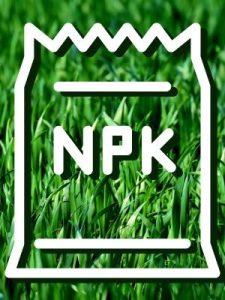The fertilizer market is big, and with so many options, it’s tough to know where to start. Know how to read fertilizer labels as you’re making your decision. Become an educated consumer, and review the following when shopping.
Fertilizer N-P-K
 An important part of how to read fertilizer labels: N-P-K. The Big 3 Macronutrients listed on fertilizer labels are numbers corresponding to the percentage weight of the bag.
An important part of how to read fertilizer labels: N-P-K. The Big 3 Macronutrients listed on fertilizer labels are numbers corresponding to the percentage weight of the bag.
- Nitrogen (N): The primary nutrient for foliar growth.
- Phosphorous (P): The primary nutrient for flowering and rooting – not necessary for growing turf grass and often banned due to water quality concerns.
- Potassium (K): The primary nutrient for the overall health of the plant.
Example: A 50 pound bag of PJC ProHealthy Turf 8-0-6 contains 4 pounds “N” and 3 pounds “K”. [50 x .08 =4; 50 X .06 = 3]
Fertilizer Application Rate
A 50-pound bag of 10-0-1 that is slated to cover 15,000 SF is only delivering .33lbsN/1000SF. [(50 x .10)/15 = .33]. Remember that these numbers are percentages of weight. So, to get the full 10% “N” or 1lb/1000SF you’d have to apply at 10lbs/1000SF which would then cover only 5,000 SF.
While you may think you’re getting bang for your buck by seeking a higher “N” and higher coverage, the math simply doesn’t add up. If you did 3 applications of 10-0-1 at the labeled rate for a 15,000 SF lawn, you’d end up just shy of 1lb N/1000SF for the season…Which is 1.5lbs/1000SF less than the minimum requirement for turf type tall fescues and perennial ryegrass and 2lbs/1000SF less than the minimum requirement for Kentucky bluegrass.
Importantly, do the math and account for the total nutrient input and product cost. You could be making a big mistake and overpaying for an inferior product.
Product Labels: Organic Materials Review Institute (OMRI)
Be on the lookout for OMRI labels. OMRI is the gold standard for truly organic products. Manufacturers go through a rigorous application process. The OMRI organization reviews each ingredient from the source, as well as the manufacturing process. OMRI serves as an independent third-party review which ensures product integrity to the US National Organic Program standard. PJC Organic has two OMRI listed products: 8-0-6 and 6-0-6. Our remaining fertilizer blends contain a subset of the materials contained in our 8-0-6 and 6-0-6 blends. Read our last blog for more info on OMRI.
Product Labels: Biosolids
Biosolids, less commonly marketed as “sewage sludge”, are a product of municipal wastewater filtration processes. Biosolids were once revered as a cheap nutrient source alternative to traditional synthetic fertilizers. New studies have discovered microplastics (PFAs) that aren’t biodegradable in biosolids. This could mean the sterilization process is no longer effective, as harmful toxins could bind to the plastics in the separation process.
Additionally, applying products containing PFAs – commonly referred to as forever chemicals – don’t break down in the soil and contaminate the water supply. In addition to potential PFAs contamination, pharmaceutical drugs also end up in the “sludge” and will likely have a negative effect on soil biology. While the consequences of using biosolids are still unknown, we’re going to steer clear of them. Biosolids aren’t 100% organic and aren’t the best option available.
Product Labels: Organic-Based
“Organic-Based” is a marketing term that misleads consumers. To market a product as “organic-based” the fertilizer must have a minimum of 15% organic material! The other 85% can be synthetic, non-organic material. If you think you are getting an organic service or product when you hear “organic-based” think again. The goal is to supplement the synthetic compounds with a little bit of organic matter to replace what’s getting depleted by running a fully synthetic program. In reality, a product labeled “organic-based” is a synthetic product, and it’s critical that more consumers are aware of this marketing tactic.
Product Labels: Poultry Litter
Poultry litter is the term used to describe a combination of chicken (or turkey) manure, urine, bedding, dropped feathers (not feathermeal). The materials are dried and processed to be used as a complete fertilizer. While litter does have a decent nutrient profile, it can be an inconsistent product and isn’t suitable for growing turf grass due to its phosphorous content. Poultry litter has become favorable in agricultural settings because it is cheap and abundantly available. Similar to biosolids, poultry litter fertilizers were created by dealing with an undesirable byproduct of chicken agriculture. As a result, nearby farmers are able to help pad their necessary nutrient inputs with litter that can be sourced close by. While it’s not my favorite option—and definitely not something I’d use in turf—I’d consider it for an ornamental garden that needed some nutrients and organic matter.
When shopping the wide market of products, it’s paramount that you know how to read fertilizer labels. As always, PJC is here to help guide your decision. Feel free to contact us or more info on what organic options will fit your lawns’ needs!








